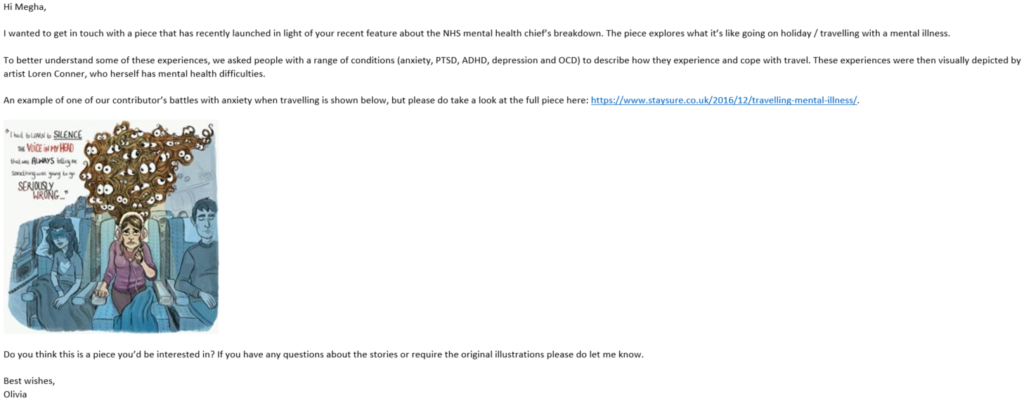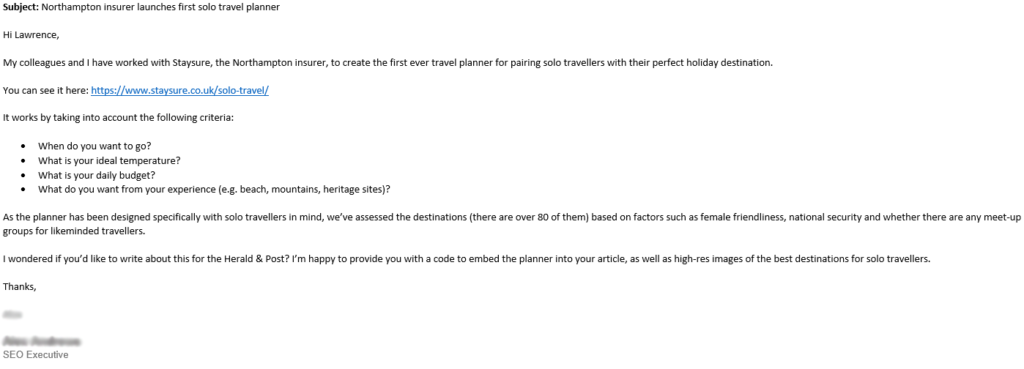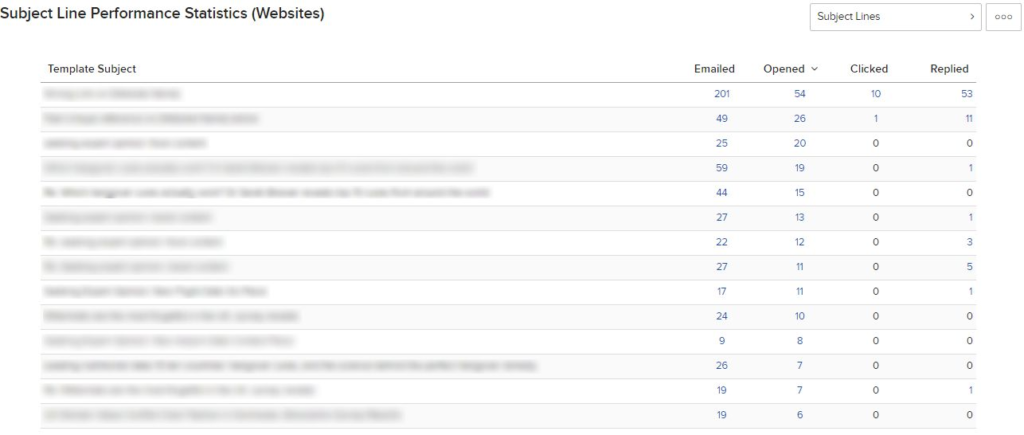The importance of your outreach email
An outreach email is a pitch – an opportunity to showcase your content, which will hopefully lead to a positive outcome. If your pitch is bad, however, then chances are your content will be rejected or, worse, simply ignored!
Everyone should, therefore, treat their initial outreach email as a one-shot opportunity (thanks Eminem). With this in mind, you need to invest time in crafting effective outreach emails.
If there was one universal agreement among the journalists I spoke to, email|was our preferred contact method
90 percent of journalists prefer to be pitched by email
Email body
Even though the subject line is the first thing your recipient sees, it’s best to save it until last because, ultimately, the body of your email will dictate what to use for your subject. So, let’s get straight to those outreach email tips and tricks.
One thing to note before we get started is that each outreach email should be unique. The degree of uniqueness of each email will vary, but it is absolutely key that every email you fire off is tailored to your recipient.
1. Be human and personalise
Remember, someone, i.e. an actual human being, will be on the receiving end of your email, so keep this in mind and write as if you were standing face to face.
The cardinal rule: always address your recipient by name.
(Arguably a little contradictory, but in the interest of the next point, I’d be sparing when it comes to pleasantries.)
Email personalisation can increase your reply rate by 100%
2. Get to the point quickly
Your recipient will have an overflowing inbox and therefore doesn’t have time to wade through paragraph after paragraph, so get to the point pronto.
Tips and tricks:
- Explain why you’re contacting the person and show them what you have to offer as soon as possible – ideally in your first paragraph
- Include no more than five short paragraphs and remember you can always provide further information in a follow-up
- If your content is live on a site somewhere, always include the URL
- If you’ve got multiple assets to share, consider uploading them to a Dropbox folder, or equivalent, to limit email body copy
- If you choose to embed image assets in your email, compress them to reduce image load times, which you can do with compression tools like TinyPNG
3. Be confident
You’ve selected your recipient to receive your email on purpose, so make it clear to them that you have something they need.
4. Be candid, but strike a balance
You’re not reaching out to your recipient for fun and games—you’re after something. What that something is will vary, however, do consider whether you should be upfront and direct about what you’re after or if you take a softer approach to avoid putting them off. I do think a softer approach is better at showing how your content can be mutually beneficial, which—in the long run—will lead to stronger, more evergreen relationships with your target contacts. When that all-important coverage of your content is published (if that’s the goal) and if a link back is missing, then that’s the moment to go back and request a link be added.
5. Safeguard your credibility
When confined to the body of an email, it’s arguably even more important to ensure you’re coming across as credible and there are some ways to bolster this:
A. Spell check
B. Review grammar (Pro tip: use Grammarly and get the relevant plug-ins)
C. Validate look and feel: Test send your email for validation and, where possible, send to different email providers, e.g. Outlook, Gmail, Yahoo! Accounts, to see if there are any inconsistencies. Testing is particularly important if you’re inserting image assets in your email body. (Pro tip: if you are manually sending multiple emails with a similar email body, then be sure to copy and paste as values, make changes and only then add the formatting.)
D. Think about your email signature: Ask yourself if you need to tweak or even remove it to give your content a better chance. I don’t think there is a hard and fast rule with this, but some questions to raise:
- Could your job title be acting as a deterrent? For example, does it spell out what your goal is with your content?
- If working at an agency, could the mention of it come across as too commercial, but also confusing if you’re positioning yourself as a representative of a different brand? If this is the case, is your client willing to provide you with an email address from which to outreach? Personally, I don’t tweak my email signature, but if you’re thinking about doing so consider if the removal or tweaking of it could jeopardise your credibility.
6. Be mindful of sentiment towards your brand
All brands are perceived differently, so ask yourself if it would be beneficial, or potentially detrimental, to mention the brand you’re outreaching for from the get-go. A not-for-profit will be perceived very differently from a gambling brand, for example.
Brand mentions examples:
- I am working on behalf of/alongside charitable social enterprise, Better.
- Experts in pest control, Rentokil, have recently revealed how quickly rats breed.
The brand you’re outreaching for should be apparent anyway, because you’ll have included a link back to where the content is available on the brand’s site. Alternatively, you’ll have disclosed the asset, which will no doubt feature the brand name somewhere.
Finally, bear in mind any breaking news stories relating to your brand. If there’s something brewing and it’s not good, it may be best to hold off on outreach until things blow over.
Here are some examples of emails


Subject lines
Having now built out your email’s body copy, the final thing to tackle is the subject line. In my opinion, this is the hardest element to tackle.
A subject line is there to get people to open an email
Joanna Wiebe from Copy Hackers
With this objective in mind, it’s safe to say that subject lines are extremely important—if not the most important—items to consider when it comes to drafting up outreach emails.
85% of editors determine whether or not they are interested in a pitch by the subject line of the email
Fractl Study
I like to compare a subject line to a teaser trailer for a film: if it’s compelling enough then chances are your target audience is going to watch the full trailer. In outreach terms, that means a good subject line translates into reading the body copy, so it’s absolutely key that you nail that line!
Teaser trailer = subject line
Trailer = email main body
Now, as we know, teaser trailers are short and snappy and, similarly, subject lines need to follow that same principle.
1. Keep it simple, but choose your words carefully
You only have room for a few words in your subject line, so make them count by only including the most important and relevant keywords.
If you’re targeting someone who favours particular buzzwords, prefers certain formats, covers regional stories or likes to include key influencers/experts then work that information into your subject line, but only if it’s relevant to your email’s main body.
Example scenarios:
Location
E.g. Northampton insurer launches first solo travel planner
Person of interest
E.g. Olympic silver medallist Kerri-anne Payne offers up her top 5 swimming tips
Format or data source
E.g. Millennials are the most forgetful generation in the UK, survey reveals
E.g. Top 10 hangover cures around the world revealed
Additionally, you need to:
2. Pay close attention to your punctuation
- Is a question mark necessary?
- Avoid emojis and excessive punctuation, such as multiple exclamation marks, unless you’re absolutely sure that they would be well received
- Exercise caution if using uppercase as it can look spammy
And finally:
3. Tone
If your content elicits a certain emotion, acknowledge it to grab your recipient’s attention!
For example:
- 9 of the world’s most precious wonders on the brink of extinction by 2020
- Women are more likely to be cast as hookers (8%) than traders (6%)
I appreciate that coming up with an attention-grabbing subject line isn’t as simple as just following the above principles, so here are a few tactics to help you:
A. Scribble down as many subject lines as you possibly can in one minute, pick your favourites and develop further.
B. Use free word combination tools like Merge Words or Kombinator for inspiration. Google Adwords Keyword Planner may also be useful if you have an account.
C. Ask the opinion of your team, friends or family.
D. Highlight your outreach email’s key points, rank them and go from there.
E. Use outreach targets’ relevant headlines to develop your own.
Much like your outreach emails, you should ensure your subject lines are tailored to your recipient. I suggest having five or six email subject line templates to hand and then simply tweak them at the point of sending off your email, if necessary.
Testing and monitoring
Finally, a note about testing. As mentioned in the email body section, it’s really important to send yourself, a colleague or even your mum a test outreach email to make sure it looks the part. I also suggest resizing your screen or opening it up on your phone to ensure that your email is mobile friendly. You should also monitor your subject lines to understand which are the most successful. A successful subject line is one that manages to get the recipient to open the email. This can be monitored in a few different ways:
1. BuzzStream
The software tracks email open rates (as well as much more) and offers up a subject line performance statistic report a bit like this:

2. Yesware
A product designed specifically to track who opens your emails, links and attachments.
Please note: some email tracking products may make the recipient aware that you’re monitoring opens and clicks, which I think can act as a bit of a deterrent when it comes to replying, but that’s entirely subjective of course.
There are a variety of email tracking plug-ins and extensions you can opt to install too, just do a quick search and take your pick.
3. LinkedIn
If you’d rather not splash the cash on a specific email tracking software and are sceptical of extensions, you can always leverage your LinkedIn profile to find out if your email subject lines are encouraging people to open your email.
Link to your LinkedIn profile within your email body copy (perhaps within your email signature) and if email recipients visit your LinkedIn profile (LinkedIn helpfully lets you know this detail) you know your email subject line has done its job.
This is admittedly a less robust way of finding out how successful your subject lines have been because a person won’t always check out your profile just because they’ve opened your email, but still a tactic worth bearing in mind.
By this point, you should be able to put a tick against all of the following:
A. Do I have several outreach email templates that I’m happy with?
B. Do I know who I am sending out my outreach emails to and has the list been well-research in line with my asset?
C. Do I have a clear order of prioritisation?
If you can respond to all of the above with a yes, then there’s one final consideration to have, which is when you should send out your outreach pitches.
Stay tuned for our final blog of the series: When to execute outreach. Or download the full whitepaper to jump ahead now.

Janet M Hughes
Excellent material. Your writing is impeccable!